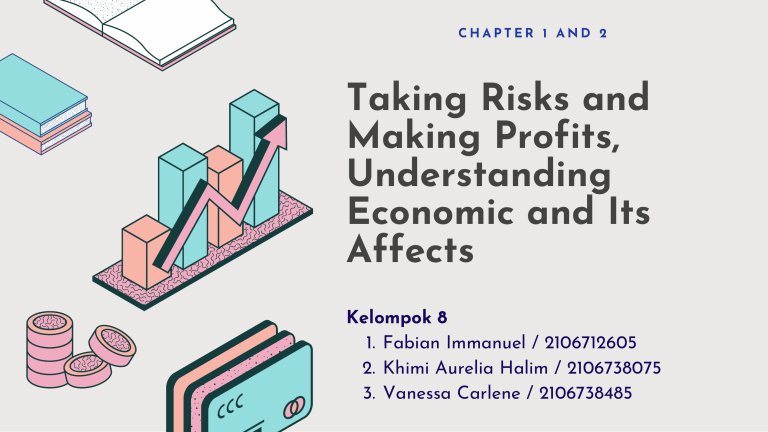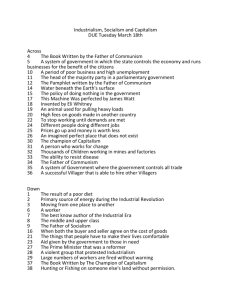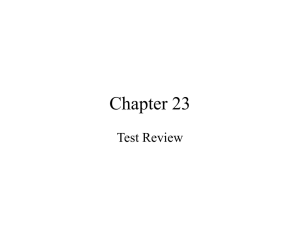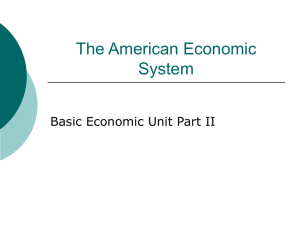Economics: Risks, Profits, and the Business Environment
advertisement

CHAPTER 1 AND 2 Taking Risks and Making Profits, Understanding Economic and Its Affects Kelompok 8 1. Fabian Immanuel / 2106712605 2. Khimi Aurelia Halim / 2106738075 3. Vanessa Carlene / 2106738485 Business and Wealth Profit A business = any activity that seeks to provide goods and services to others while operating at a profit Profit = the amount of money a business earns above and beyond what it spends Loss = when a business’s expenses are more than its revenues Bigger risk can mean bigger profits or bigger loss Standard of Living and Quality of Life Standard of living = the amount of goods and services people can buy with their money Goods cost more in some countries because of higher taxes and stricter regulations Quality of life = general well-being of a society BUSINESSES AND THEIR EMPLOYEES PAY TAXES GOVERNMENT BUILD PUBLIC FACILITIES CONTRIBUTES TO THE STANDARD OF LIVING AND QUALITY OF LIFE FOR EVERYONE IN THE COUNTRY Various Stakeholders and nonprofit organization A challenge for organizations in the 21st century is to recognize and respond to the needs of their stakeholders Stakeholders consist of : customers, employees, stockholders, suppliers, dealers (retailers), bankers, community, media, environmentalists, competitors, government leaders The knowledge and skills from business's course are useful for careers in any organization, including nonprofits organization (organization whose focus on social and educational goals). Two ways to succeed in business 1 Rise through the ranks of a large company (less risky and the company provides you benefits) 2 Become an entrepreneur (riskier and you provide benefits for yourself) five factors of production 1 Land & other natural resources 2 Labor 3 Capital 4 Enterpreneurship (critical element) 5 Knowledge (critical element) The Business Environment 1. The economic and legal environment What the governments can do to help businesses? Allow private ownership of businesses Minimize interference of free trade in 2. The technological environment 3. The competitive environment 4. The social environment goods and services Passing laws that enable entrepreneur writes enforceable contracts Establish a currency that is tradable in world markets 5. The global business environment Minimize corruption The Technological Environment Technology makes business people do their job easier, more effective, efficient, and productive The more technology is used, the fewer workers are needed E-commerce becomes so important, either the B2B or B2C markets Technology helps businesses respond to customer needs by using database for ads and subscription mail Technology also opens the possibility of identity theft The Competitive Environment Every company's goals is no mistakes on their product Business nowadays is customer-driven rather than management-driven Company must give their frontline workers the responsibility, freedom, and others to respond quickly to customer requests Company must allow workers to make other decisions to producing high-quality goods and services The Social Environment Demographic trends affect business and career choices Diversity nowadays not just about minority and female employees Some governments are making efforts to adapt with diversity Businesses that serve older consumers needs will have the opportunity in the future Social Security for retire people will reduce the economy wealth Single-Parent Families effect businesses to implement some programs THE GLOBAL ENVIRONMENT Two important modifications: 1. Increases the international competition 2. Makes bigger free trade among nations World trade has grown because of the efficiency of distribution systems and communication advances THE BENEFITS AND COSTS 1. War and Terrorism: Make the government spend greater cash on spying and the military. 2. How Global Changes Affect: As businesses enlarge to serve global markets and new jobs will be created in manufacturing and service industries. 3. The Ecological Environment: Climate change, global warming, and few issues have been captured by the international business community. HOW PAST TRENDS ARE BEING REPEATED 1. Progress in the Agricultural and Manufacturing Industries In the U.S. , since the 1800s, the agricultural industry has led the way The changes are small farms have been replaced by some huge farms, some merely large farms, and some but highly specialized farms. The farmers who lost their job during the 19th and 20th centuries work in factories. The farms began using new technology, tools, and machines to become more productive Many workers in the industrial sector found jobs in the growing service sector People who can’t find work nowadays are people who need retraining and education. 2. Progress in Service Industries In this modern time, the fastest-growing companies provide services Services make up almost 80% of the value of U.S. economy There are more high-paying jobs in the service sector than in the goods-producing sector. Basic Economic Economics = The study of how society chooses to appoint sources to produce items and offerings and distribute them for consumption. In economics, there are macroeconomics (nation) and microeconomics (each person and organization) Businesses can contribute to an economic system by inventing products that greatly increase available resources The Secret to Creating A Wealthy Economy In developed countries, population growth are slower than in developing countries An educated large population can be a valuable resource Macroeconomists need to research what makes some countries wealthy and the others don't and to implement policies and programs that increase prosperity. Adam Smith and the Creation of Wealth Freedom was necessary to the survival of any economy (to own land and to preserve profits) People will work longer and harder if they have incentives for doing it How Businesses Benefits the Community Business people's efforts are referred to an “invisible hand” that helps the financial system develop and prosper through the production of needed goods, services, and ideas. CAPITALISM AND HOW FREE MARKETS WORK Free-Market Capitalism In capitalism, most factors of manufacturing and distribution are owned by individuals and for their own profit. State capitalism: A mixture between freer markets and authorities control Four basic rights under free-market capitalism : The right to own private property The right to own a business and keep all that business's profit The right to freedom of competition The right to freedom of choice The advantage of the four primary rights is people are willing to take greater risks than they should. How Free Markets Work What and how much to produce are made by the market Prices are determined by buyers and sellers in the marketplace If something is wanted but isn’t available, the price tends to go up Goods rarely shortage in a long-term Demand The quantities of products that people are willing to buy at different prices in a specific time. The lower the price, the more people willing to buy. Supply The number of products that the owners are willing to sell at different prices in a specific time. The higher the price, the more seller willing to supply. The equilibrium The supply and demand curve would cross where quantity and price that are demanded and supplied are equal That price will be market price COMPETITION WITHIN FREE MARKETS BENEFITS OF FREE MARKETS Allows open competition among Perfect Competition (many sellers) companies Monopolistic Competition (large number of sellers) Encourages companies to be more Gives opportunities for poor people to work and get out of poverty efficient LIMITATIONS OF FREE MARKETS Oligopoly (few sellers) Some people allow themselves to be dictated by greed The business owners and managers are Monopoly (1 seller) getting richer, but the lower-level workers not Not all people can start a business Socialism and Communism Socialism may be beneficial to social equity Socialism may result in fewer inventions than in a capitalist system One of the disadvantages that may happen in a socialist system is a condition called Brain Drain Problems within communism include the lack of knowledge the government has on knowing things to produce. Communism doesn't inspire businesses to work hard TREND ABOUT MIXED ECONOMIES Free Market Economies: The market determines the majority of sectors, usually called capitalism Command Economies: The government takes control of the whole sector, usually referred as socialism and communism The mix of the two systems hasn't resulted in optimal economic conditions. Mixed economics: allocation of resources are some made by the market and some by government. Comparisons of Key Economics Systems U.S. Economic System Key Economic Indicators : Gross Domestic Product (GDP) Unemployment Rate Price Indexes GDP Total value of final goods and services produced in a country in a given year. The growth and decline of GDP affects businesses. Gross Output (GO) is considered a better indicator of business cycle than GDP The Unemployment Rate Seasonal Unemployment : Demand for labor varies Cyclical Unemployment : Caused by recession/downturn cycle Structural Unemployment : Caused by the restructuring firms Frictional Unemployment : Quit work and haven't found a new job Price Indexes Price indexes can be a gauge for the health of the economy by measuring the levels of inflation, disinflation, deflation, and stagflation The Business Cycle 1 2 3 4 BOOM RECESSION DEPRESSION RECOVERY Business is Booming GDP Declines for two or more consequtive quarters Severe recession with deflation Economy stabilizes and grows Fiscal and Monetary Policy TO STABILIZE THE ECONOMY Keynesian Economic Theory The theory that a government policy of increasing spending and cutting taxes could stimulate the economy in a recession. FISCAL Lowering tax rates to give economic boost Cut government spending (if the economy is in deficit) MONETARY Raising or lowering interest rates Controls the money supply Source Nickels, William G., James M. McHugh, & Susan M. McHugh. (2019). Understanding Business Twelfth Edition. New York : McGraw-Hill Education https://www.britannica.com/topic/supply-anddemand






